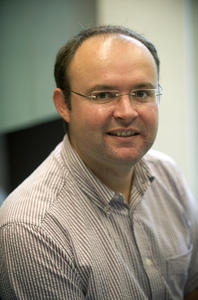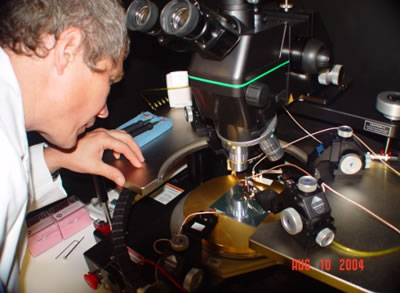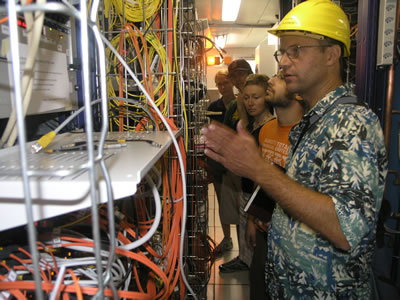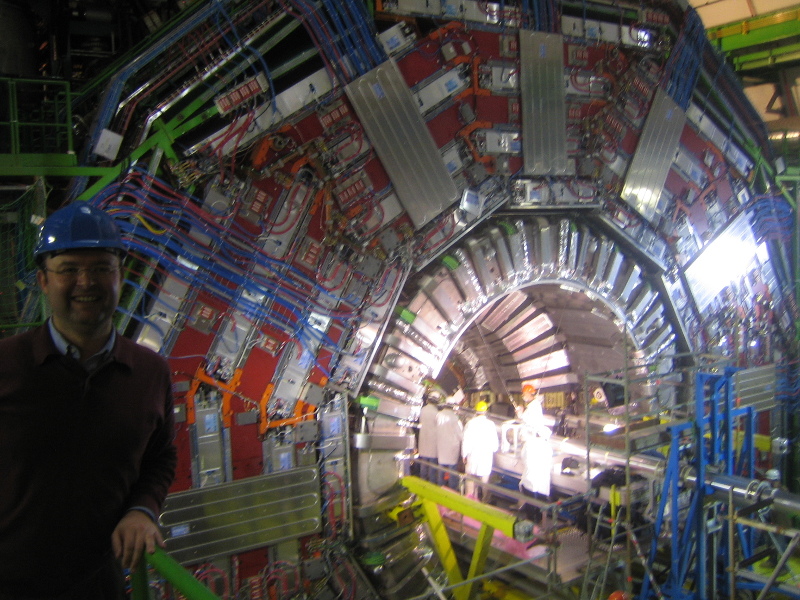Rochester at the Highest Energy Frontier
 This March 30th, the highest energy accelerator in the world will begin operating with two beams of 3.5 Tera-electron-volt (TeV) protons colliding head-on, thereby extending the energy frontier deeper into the unknown regions of the Terascale. A group of University of Rochester physicists are among the several thousands who have contributed to designing and constructing the detectors that will collect and analyze the data in these collisions for years to come.
This March 30th, the highest energy accelerator in the world will begin operating with two beams of 3.5 Tera-electron-volt (TeV) protons colliding head-on, thereby extending the energy frontier deeper into the unknown regions of the Terascale. A group of University of Rochester physicists are among the several thousands who have contributed to designing and constructing the detectors that will collect and analyze the data in these collisions for years to come.
Following a long recovery from an explosion in its cryogenics system in September 2008 that brought it to a halt a week after initial turn-on, the Large Hadron Collider (LHC) in Geneva, Switzerland is ready for stable operations. After extensive repairs and implementation of quality assurance for thousands of components, the accelerator broke the record for highest-energy collisions at 2.4 TeV this past December. Now it is ready for 18 months of productive operations at a new record of 7 TeV.
The LHC hopes to respond to some of the most puzzling questions about our universe, such as, what is responsible for the mass of elementary particles and whether there are new particles and forces to be observed at the higher energy, as is anticipated from theoretical arguments. The LHC will also provide the opportunity to measure with greater precision the properties of currently known particles that require additional study. To do all that, protons will be accelerated in opposite directions around the 17-mile underground circular accelerator tunnel at a rate of 11,000 laps per second, and collided head-on within four major detectors. At the moment of impact, the energy of the protons is transformed into other massive particles that can be studied in the detectors.
Members of the Department of Physics have collaborated on the Compact Muon Solenoid (CMS) detector since 1994, and constructed two crucial parts of this 12,000 ton, four-story high device. Prof. Arie Bodek led the initial proposal, construction, and commissioning stages for the Hadronic Calorimeter, designed to measure energies of "showers" of particles such as pions that originate from quarks. This group built and installed the active material of the hadronic calorimeter, consisting of 70,000 plastic scintillator tiles, read out using optical fibers. These tiles cover the whole volume of the cylindrical calorimeter, which is 9 meters long, 1 meter thick and 6 meters at its outer diameter, and contains a total of 9,000 individual readout channels. Since 2000, a group led by Prof. Regina Demina prototyped, tested, and commissioned a large fraction of the high-precision silicon devices needed to measure the position of charged particles as they emerge from the collision point. Demina is the co-manager of this U.S. part of the project, which involves 200 square meters of sensors made of 100 kg of silicon, and millions of readout channels. Rochester scientists were crucial in the production and testing of 50% of all the silicon modules, maintaining a rejection rate for bad channels of only 0.06%, and identifying and correcting any design flaws.

Engineer Sergey Korjenevski tests the setup for the Silicon sensor probing at Rochester
![]()
Postdoc Yuri Gotra at the tracker assembly facility at CERN
The current contingent of the physics department participating in CMS includes five faculty, two senior scientists, two engineers, four postdocs, seven graduate students, six undergraduate students, as well as four past REU students hosted by UR who worked on CMS. Group members are playing leading roles in the preparation for first data taking, hoping to improve the understanding of the complex detectors and how to extract the physics information from the recorded collisions. Senior scientist Pawel de Barbaro is the "field coordinator" for the Hadronic Calorimeter and one of the managers of the CMS run. Postdoctoral Fellow Pablo Goldenzweig is a calorimeter on-call expert in charge of developing new readout electronics. Senior scientist Marek Zienlinski is the leader of the jet algorithms group, and Marshak Fellow Henning Flaecher is the coordinator of data validation for the Supersymmetry (SUSY) analysis. Prof. Slattery, senior scientist George Ginther and the now deceased Prof. Fred Lobkowicz built a moveable test beam table that allowed a sector of the CMS calorimetry to be tested and calibrated. Prof. Garcia-Bellido is contributing to the readout electronics of the hadronic calorimeter. Although not participating currently in the CMS effort, Prof. Ferbel was the manager of the entire U.S. LHC program for four years (2004-2008).

Senior Scientist Pawel de Barbaro, grad student Dan Miner, Prof. Regina Demina, and undergrad students Ben Auerbach and Sarah Lockwitz in one of the electronics rooms in CMS

Prof. Garcia-Bellido in the CMS cavern, 300 ft underground, in March 2009
--Submitted by Assistant Professor of Physics Aran Garcia-Bellido
» read the article as posted on Professor Aran Garcia-Bellido's webpage
